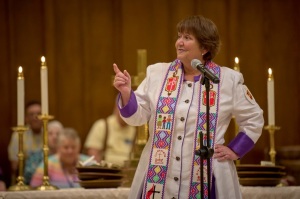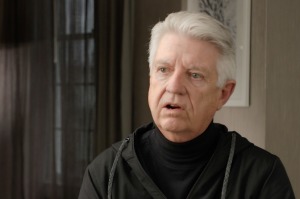Is There Scientific Evidence for the Resurrection of Jesus Christ?
I believe the resurrection of Jesus Christ is an historical reality. The resurrection is on solid historical grounds, independently of what I am about to talk about. Jesus appeared to His disciples---the original skeptics of the resurrection---over a period of 40 days, offering them "many infallible proofs." They in turn went out and turned the Roman Empire upside down with the message of the cross and resurrection.
In addition to the massive historical evidence for the resurrection, I believe there is scientific evidence for the resurrection, and it is to be found in the Shroud of Turin, a linen cloth 14 feet by 3 feet, that purports to be the actual burial cloth of Jesus Christ.
The Man in the Shroud was badly scourged, was crucified, wore a crown of thorns, and was stabbed in the chest with a Roman spear.
Here's what the late Dr. D. James Kennedy once remarked when he first heard about the Shroud: "I should confess that when I first heard about the so-called Shroud of Turin my attitude was one of great skepticism. I have never been impressed with relics. There are enough pieces of the 'genuine' cross of Christ to build the ark, and there are at least forty other shrouds which are claimed to be the Shroud of Christ. Was this thought to be any different? I must confess that I, for one, did not think so at all. But it should be required of every honest person-certainly of every Christian-to have an open mind and to examine the evidence. Christianity is based upon evidence. What does the evidence say?" As Dr. Kennedy studied the evidence, he became convinced that the Shroud really was the burial cloth of Jesus.
One of the great experts on the Shroud in our day is Dr. Alan Whanger, a retired professor from Duke Medical Center who has spent his life studying medicine. Since the late 1970s, he has studied intensely the Shroud of Turin.
Although the Shroud was dismissed by some as a fake because of the carbon-dating in 1988 of a single specimen (divided into three tiny parts) that was said to date from 1260 to 1390 A.D., Dr. Whanger says that test was not valid. He and his wife Mary (co-authors of the book The Shroud of Turin: An Adventure of Discovery, Franklin, Tenn.: Providence House Publishers, 1998) say that the problem was not with the dating per se. It was with the sample. It was from the very corner of the cloth, from a part rewoven in the Middle Ages. And so he concludes, "the carbon dating was totally invalid and has no scientific merit to it at all."
Furthermore, Dr. Whanger notes, "The Shroud is the most intensely studied single object in existence. There are probably 67 different fields of scientific and academic interests that have looked into the Shroud in one way in another. So, there's been a huge amount of research gone in on it. It is our conviction that the Shroud is, indeed, the burial cloth of Jesus of Nazareth. And we feel that we can date it to the spring of 30 A.D. in the Middle East, and that what we see on the Shroud with the various wounds that this is entirely consistent with the scriptural account of the crucifixion of Jesus. And traditionally, this has been known as the image of Jesus." In other words, observes Dr. Whanger, what we think Jesus looked like is based on the Shroud of Turin and not vice versa.
We know where the Shroud has been since 1357, when it showed up in Lirey, France in the home of a French crusader. Knowing it dates from 1357 or earlier, consider all these details:
•The human anatomy represented on the Shroud is 100% correct. Knowledge about anatomy on the Shroud includes details that weren't known until the 20th century. In contrast, 14th century knowledge of anatomy was quite limited. If the cloth were the work of a medieval forger, he knew things that weren't to be known until centuries later.
•The Shroud was photographed for the first time in 1898, and it was discovered to be a photographic negative---hundreds of years before photography was invented.
•The faint image on the Shroud was not painted on. It was lightly burned on. It's as if at the moment of the resurrection, Christ's body let off a burst of radiation, as His body changed from mortal to immortal. The image on the Shroud is created by some sort of scorching process. Yet it is only lightly scorched. The image is only 5/1000's of an inch thick. Although there are a few traces of pigment on the Shroud (because as a holy relic, they put paintings in contact with it, presumably to receive a blessing or the like), the image is not comprised of pigment or paint.
•The blood on the Shroud is real human blood---with all the wounds corresponding with the passion of Jesus in the Gospels. The blood did not see decay (He was sandwiched inside that cloth for less than 72 hours). Yet the blood was undisturbed, which means He somehow went through the cloth; it was not yanked off Him.
•What we think Jesus looked like is based on the Shroud of Turin. People have a universal picture of how they think Jesus looked. That image is based on the Shroud.
•While leading evangelicals are often silent about the Shroud, and I respect that, I still think people should look into it for themselves because the evidence is there, on yet another front, declaring the Easter message: Jesus is risen.
•In the Middle Ages (and even sometimes today) artistic representations of the crucifixion place the nails in the palms. Yet the Shroud of Turin places the nails in the wrists. It has now been medically proven that nails in the palms would not suffice to hold a crucified man. (The Greek word for "hand" can also mean wrist.)
•The image of the Shroud is three-dimensional. When ordinary photos or paintings are studied through a specific NASA, space-age machine (a "VP 8 Image Analyzer"), the image always becomes distorted. However, the Shroud has been proven to have three-dimensional properties. It could not have been a painting.
•The theories of skeptics put forward to explain away the Shroud pay indirect homage to its awesome properties. For example, one recent book proposed that no less a genius than Leonardo de Vinci produced the Shroud-and that he had to secretly crucify a man in the process. However, Leonardo lived a hundred years after the Shroud appeared. So there goes another theory. Everyone that studies the Shroud of Turin agrees that this is a mystery not easily explained away.
If it's a hoax, this is no ordinary hoax. The greater evidence argues for its authenticity. As some scientists put it, the Shroud is, if you will, a "snapshot of the resurrection." At the very moment Christ rose from the dead, something happened-a burst of radiation perhaps-that left a permanent mark on the front and back of the burial cloth that sandwiched the Man who wouldn't stay buried for long. In short, the best theory is that the Shroud of Turin provides scientific evidence for the resurrection of Christ.
He is risen. He is risen indeed!
READ WHY ONE PASTOR SAYS THE BIBLE HAS BEEN SCIENTIFICALLY PROVEN




























